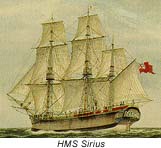
Sydney's European History
Settlement

After deciding that Botany Bay was not suitable for the settlement, Phillip rowed north to Port Jackson. On his arrival in Port Jackson Phillip fixed on a cove that he believed had 'the best spring of water, and in which the ships can anchor so close to the shore that at a very small expense quays may be made at which the largest ships may unload'. Phillip named the cove Sydney Cove after the British Secretary of State, Viscount Sydney. On January 26, 1788, the First Fleet sailed north to Port Jackson, Phillip having left the day before to begin clearing land at Sydney Cove. It wasn't long before the colony established itself and for the next 60 years it would be the new home to unwanted, persecuted and criminal elements of British society.
The Rum Rebellion
It wasn't long before the inexperienced farmers utilising patchy European farming methods found themselves on the brink of starvation. Combined with disease and low morale, the colony was in desperate trouble. Despite the harrowing experience of the First Fleet's settlement the second and third fleet of convicts and military settlers followed soon after the First. In 1808, Governor William Bligh was overthrown by the New South Wales (Rum) Corps whom had commercial interests in the Rum trade, this became known as the Rum Rebellion.
Gold Rush
By 1840 the colony's population was made up of mainly free immigrants and transportation ceased in 1842. By 1847 the convict population of Sydney accounted for only 3.2 percent of the total population. Thanks to Edward Hargraves bringing his discovery of gold from the west to the colony in 1851 and word that gold had been discovered in Victoria, settlers began leaving Sydney for the prospect of becoming rich. The gold rush that ensued attracted miners and prospectors from all over the world. Despite the mass exodus of settlers, Sydney's population grew from 54,000 to 96,000 in 1961 due to the growth in immigration.
Federation
Australian Federation occurred in 1901 and the Commonwealth of Australia was declared in a ceremony in Centennial Park. The first world war spurned an economic boom for Sydney, however, with the artificial spending stimulant of the war over, the economy went into rapid decline and over a third of Sydney siders were unemployed during the Great Depression of the early 1930's.
Sydney Harbour Bridge

In 1932 with the increase in wool prices and the opening of the Sydney Harbour Bridge, the economy was back on track. Post WWII the population of Sydney swelled again with the influx of European immigrants and due to immigration policies of the day the population of Australia was 99.4 percent European by 1947.
Sydney's Rocks Precinct
Sydney's Rocks area will give you a real sense of how the first European settlers lived as this is where the place that many of them called home. The area is a living museum of life in a bygone era. While the area has been modernised and is a bustling business centre today, many of the buildings, cobble stone streets and lane ways are still largely intact and some of the pubs such as the Argyle Hotel have kept some of the original timber work inside.
International City
Today Sydney is one of the most cosmopolitan, culturally diverse and aesthetically beautiful cities in the world. The harbour is only rivaled by that of Hong Kong and with its 20 or so beautiful swimming beaches and pleasant climate Sydney has become an extremely popular tourist destination attracting almost 3 million visitors annually.
Related Links
Quick Find
Visitor Information
- General Information
- Photo Gallery
- Sydney Maps
- Sydney Beach Guide
- Getting There
- International Visitors
- Sydney News